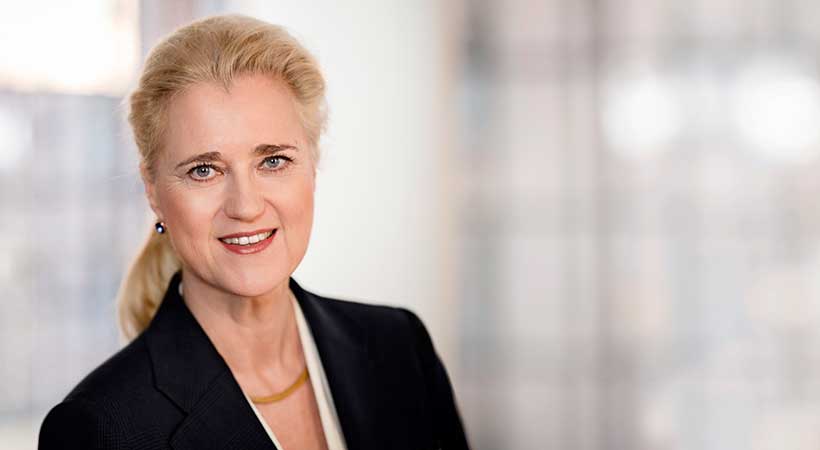Statement from the Chairwoman of the Executive Board

Ladies and Gentlemen,
We pursue a sustainable business model by doing business responsibly and with a focus on the future. It is our firm belief that profitable growth and future business success depend to a great extent on acting in a forward-looking and responsible manner. We have enhanced our sustainability efforts by successfully implementing a number of economic, environmental and social measures. The use of state-of-the-art technology, compliance with best-practice social standards, the implementation of highly efficient business processes and value-based corporate governance are the core elements of our sustainability strategy. In other words, sustainability in thought and deed is at the heart of all HHLA’s business decisions.
Ecologically sustainable transport chains lay the foundation for our economic success. This is why we have increased our investment in intermodal transport. We set standards in environmentally friendly transport with our value-adding investments in highly efficient hinterland terminals, eco-friendly electric locomotives, hybrid shunters and quiet container wagons. In this way, we have successfully transferred traffic from road to rail while attracting and retaining cargo for our seaport terminals. In 2016, we added two tracks to the rail terminal at our Container Terminal Altenwerder, taking the total to nine. This increased the terminal’s capacity by 140,000 to 930,000 standard containers. HHLA has thus once again made an important contribution towards strengthening the Port of Hamburg, Europe’s largest “rail port”.
As well as transferring freight transport from road to more eco-friendly rail, the implementation of our sustainability strategy is also determined by the business processes at our terminals. Automated, electrified processes and equipment play a vital role in helping us reach our environmental and climate protection targets, while also improving space efficiency. The trend towards ever-larger ships and the subsequent increase in peak loads at our facilities requires greater energy consumption. We are combating this development by using energy-efficient devices and optimizing our processes. In addition, we are replacing our diesel-powered devices and equipment with electric technology. We use electricity from renewable sources in order to reduce CO2 emissions. Based on the positive experience we have made so far with battery-operated automated guided vehicles (AGVs), we took the decision in 2016 to replace all remaining diesel-powered AGVs with electric AGVs. The uptake of e-mobility has been slower than expected in Germany – but not at HHLA. Our fleet of electric cars was expanded by 10 percent to 77 vehicles in the reporting period. This means that we now have the largest e-vehicle fleet of any European port.
In view of the measures implemented and resolved in the past financial year, we are confident of reaching the climate protection goal we set ourselves by 2020. Based on our 2008 figures, we aim to reduce our CO2 emissions per container handled by at least 30 percent by 2020. At the end of 2016, we had already achieved a reduction of 27.3 percent. Our increased use of electric technology not only reduces climate-damaging CO2 emissions, it also cuts local emissions of other harmful substances and noise. In this way, HHLA is making a measurable contribution towards improving local air quality.
HHLA operates in eleven European countries and approximately one third of its employees are based outside Germany. We offer our 5,500-plus employees a wide range of benefits and workplaces that meet the highest occupational health and safety standards. The modern business world is undergoing radical change. In order to meet this challenge, we strive to continuously enhance the skills of our employees. Specialised vocational training and professional development programmes help them acquire the necessary knowledge. Our employees are the foundation upon which we can build our long-term success. This belief is also reflected in our HR strategy, which considers such aspects as a healthy work-life balance and diversity criteria.
Our real estate experts continue to drive the sustainable development of Hamburg’s Speicherstadt historical warehouse district – designated a UNESCO World Heritage Site – taking into account its listed status and the unique characteristics of this district.
HHLA takes social responsibility by supporting various projects that focus on maritime economics and environmental topics at primary schools in Hamburg. For as the events of 2016 have shown, education is a vital prerequisite for public debate and cohesion in a democratic society.

Angela Titzrath
Chairwoman of the Executive Board
Payments for investments in property, plant and equipment, investment property and intangible assets.
Transportation via several modes of transport (water, rail, road) combining the specific advantages of the respective carriers.
A port’s catchment area.
In maritime logistics, a terminal is a facility where freight transported by various modes of transport is handled.
In maritime logistics, a terminal is a facility where freight transported by various modes of transport is handled.
A TEU is a 20-foot standard container, used as a unit for measuring container volumes. A 20-foot standard container is 6.06 metres long, 2.44 metres wide and 2.59 metres high.
A fully automatic, driverless transport vehicle which carries containers back and forth between the container gantry cranes on the quayside and the block storage yard at the HHLA Container Terminal Altenwerder.